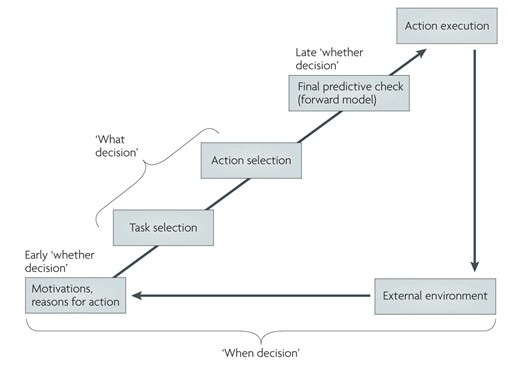What is the final common path of voluntary action
The Primary Motor Cortex
Do fMRI studies show sensory motor activation when you are planning an action?
No. Planning an action does not involve sensory motor activation.
Describe one general experimental design that can be used to overcome some of the challenges involved with studying volition
1. Participant performs a set action but chooses when
2. participant chooses the action they perform at a set time
3. participant chooses whether or not to perform an action
Conscious intentions contain information about which body part will be moved. How do lateralized readiness potentials support this idea?
The brain area contralateral to the body part that will be moved is higher than the ipsilateral activity. Lateralized readiness potentials show that preparation to make a movement is more body part specific than a general preparation to move.

During which decision might a veto be considered?
The late whether decision
What colour is the star at the approximate time that basal ganglia activity can first be observed prior to movement?
Blue
Would John Searle argue that volition is teleological? why?
Yes. He would argue it is teleological. He views raising his arm as the result of a consious goal that he made. The goal to raise his arm is what resulted in his arm being raised.
Libet suggested there might not be free will, but there might be something called 'free won't', a conscious veto of an action. Can you think of a problem with this idea? Hint: think of dualism
Dualism of a conscious veto is just as problematic as dualism of free will. The veto could just as well be the consequence of some preceding neural activity, with the conscious awareness occurring only right before the veto reaches threshold.
What does the retrospective insertion view of conscious intention suggest about conscious intention?
That conscious intentions are inserted after movement has occurred to explain to ourselves why we just moved.

How does Anarchic hand syndrome support the idea that the PreSMA is involved in task selection decisions?
Anarchic hand syndrome results from lateralized damage to the preSMA. The contralateral hand is hyperresponsive to environmental stimuli. This supports the idea that the preSMA is involved in keeping volitional action 'on task'.